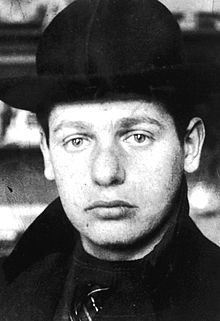Michel de Klerk
Michel de Klerk (born November 24, 1884 in Amsterdam ; † November 24, 1923 there ) was a Dutch architect. He is considered one of the main representatives of the Amsterdam expressionist school .
Early years
De Klerk was born in 1884 as the 25th child of a 78-year-old diamond cutter, who died in 1887. Michel grew up in poverty in the Jewish quarter of Amsterdam. But since he already showed great talent in drawing in elementary school, he was able to attend a higher school. In 1898 the architect Eduard Cuypers gave the fourteen-year-old a job as a service boy in his office, where de Klerk was to stay for twelve years. There also worked Johan van der Mey and Piet Kramer , the three main representatives together with de Klerk Amsterdam School should be.
Amsterdam school
Even though Cuypers himself was a fairly traditional architect, he gave his staff a lot of freedom and gave them access to his extensive library. In addition, he took particular care of de Klerks and trained him to be a draftsman . In this atmosphere, de Klerk and his employees were able to develop their talents. After de Klerk married a secretary van Cuypers in 1910 and made a trip through Scandinavia, he settled down as a draftsman in Sloten . His first commission was for a house in Uithoorn in 1911. The architect and project manager HAJ Baanders then commissioned de Klerk to design an apartment block for workers in Amsterdam.
Since then his name has been primarily associated with 'social housing'. His most famous building is the Het Schip residential complex in Amsterdam. Together with Kramer, de Klerk also designed a large complex for the social democratic cooperative 'De Dageraad', also in Amsterdam. De Klerk's left political views certainly played a role in awarding the contract.
Berlage plan
When the expansion of Amsterdam began in 1918 according to a plan by HP Berlage ('Plan Zuid'), de Klerk was one of the architects in charge. The size and the political importance of the project, however, severely limited his creativity. Therefore he limited himself to individual orders. When this proved unsuccessful, he became increasingly depressed. The last major work was the department store 'De Bijenkorf' in The Hague by Piet Kramer, which also marks an end point of the Amsterdam School as an architectural style. Before the draft was finished, de Klerk died of pneumonia on his 39th birthday. His last project, the spire of a reformed church in IJsselstein , was carried out after his death at the instigation of his wife. His wife Lea was murdered in Auschwitz and his youngest son in Sobibór. The eldest son survived the world war.
Work (selection)
Web links
Individual evidence
- ↑ Michel de Klerk in the Encyclopaedia Britannica (accessed November 24, 2013)
| personal data | |
|---|---|
| SURNAME | Klerk, Michel de |
| BRIEF DESCRIPTION | Dutch architect |
| DATE OF BIRTH | November 24, 1884 |
| PLACE OF BIRTH | Amsterdam |
| DATE OF DEATH | November 24, 1923 |
| Place of death | Amsterdam |






